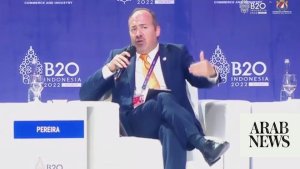LONDON: The Organization of the Petroleum Exporting Countries on Tuesday stuck to its forecasts for robust global oil demand growth in 2022 and 2023 citing signs that major economies were faring better than expected despite headwinds such as surging inflation.
Oil demand will increase by 3.1 million barrels per day in 2022 and by 2.7 million bpd in 2023, unchanged from last month, OPEC said in a monthly report.
Oil use has rebounded from the lows of the pandemic, although high prices and Chinese coronavirus outbreaks have trimmed 2022 projections. The downgrades, in OPEC’s view, have delayed a recovery in oil use to above 2019 levels until 2023, it said last month.
“Oil demand in 2023 is expected to be supported by a still-solid economic performance in major consuming countries, as well as potential improvements in COVID-19 restrictions and reduced geopolitical uncertainties,” OPEC said in Tuesday’s report.
It expects world oil consumption in 2023 to average 102.73 million bpd, above the pre-pandemic rate during 2019.
Earlier this year, OPEC had forecast a move above pre-pandemic demand levels in 2022.
OPEC left its 2022 and 2023 global economic growth forecasts steady at 3.1 percent and the report pointed to signs of activity holding up, such as retail spending in the United States and Euro-zone, and stressed the potential for upside risks.
“While the US and China especially were facing challenges in the first half of 2022, their economies are very likely to recover in the second half,” the report said.
“The euro zone enjoyed an unexpectedly strong first half of 2022 despite weak sentiment and inflationary trends.”
Oil prices traded lower after the OPEC report was released, slipping below $94 a barrel.
Output boost
OPEC and allies including Russia, known as OPEC+, have this year been ramping up oil output as they look to unwind record cuts put in place in 2020 after the pandemic slashed demand.
However, OPEC+ in recent months has failed to achieve its planned output increases due to underinvestment in oilfields by some OPEC members and by losses in Russian output.
OPEC’s monthly report showed OPEC output posted a sizeable gain in August, rising by 618,000 bpd to 29.65 million bpd, although much of this was due to Libyan supply recovering from outages, according to figures from secondary sources.
Top exporter Saudi Arabia told OPEC it made a larger August boost than the secondary sources reported, raising output to just over 11 million bpd, up 236,000 bpd from July, leaving the world’s cushion of unused capacity thinner.
Saudi Arabia says it has a maximum capacity of 12 million bpd and some industry sources have questioned whether the country can pump 11 million for very long. (Reporting by Alex Lawler; editing by Jason Neely)










